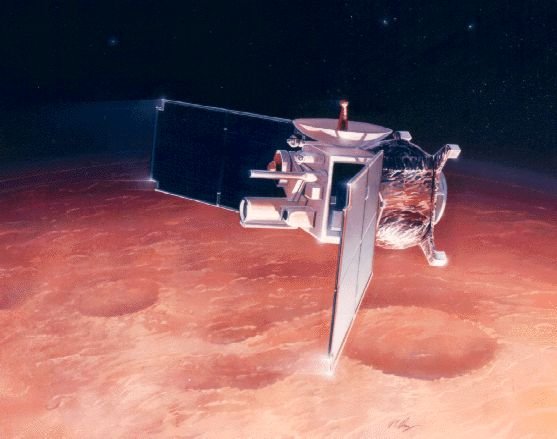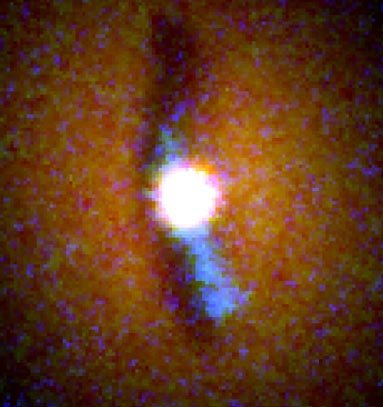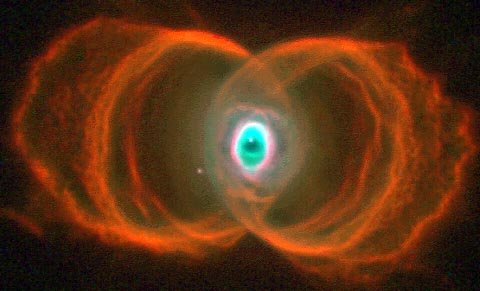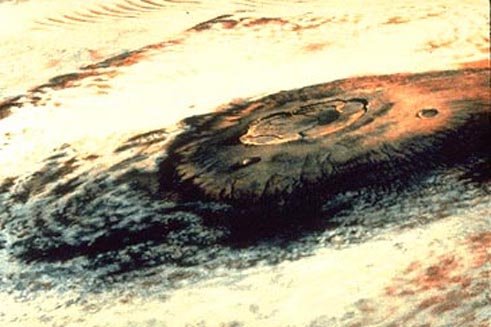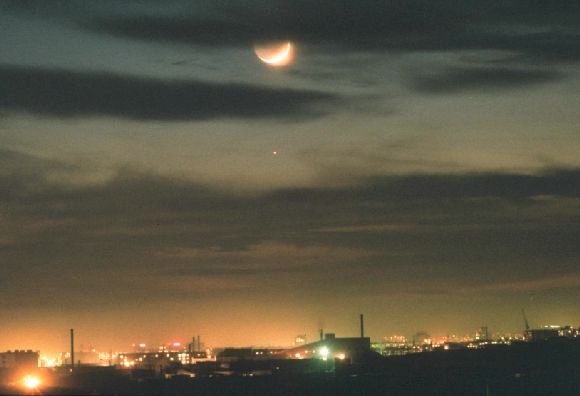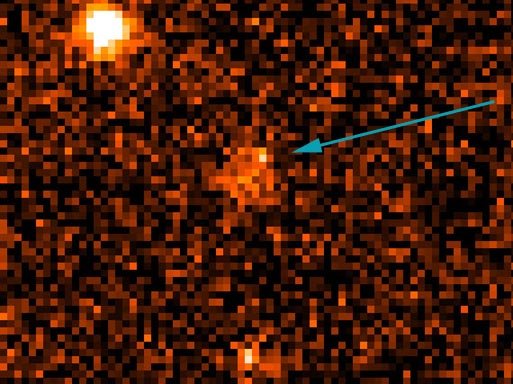NASA APOD #815-821
#815 Mars Global Surveyor: Aerobraking September 11, 1997
“Completing a 10 month journey, another spacecraft from Earth arrives at Mars today. The Mars Global Surveyor (MGS) is scheduled to fire its main rocket engine for 22 minutes at 6:17 p.m. PDT and enter a highly elliptical orbit, with a low point 186 miles and a high point 34,800 miles above the surface of Mars. This robot spacecraft is aptly named. Its mission is to undertake a detailed planetwide survey of Mars. But first MGS must circularize its orbit, lowering the high point to about 250 miles. Instead of relying solely on its rocket engine, MGS mission controllers will use a fuel-saving technique known as aerobraking - dipping the spacecraft into the Martian atmosphere where it will encounter increased atmospheric drag. This early artist's conception emphasizes the drag created by the wing-like solar panels. The cumulative effect should find MGS in a more circular mapping orbit by March 1998. To successfully use aerobraking, mission controllers must achieve an exact orbit and will be handicapped by a limited knowledge of the thickness of the Martian atmosphere. They may even need to alter the spacecraft's course to compensate for changes in Martian weather."
Copyright: Public domain
#816 The Center of NGC 6251 is Glowing September 12, 1997
“Something is lighting up the center of galaxy NGC 6251. Leading speculation holds that it is a large black hole not shrouded by gas and dust typically found near the center of a galaxy. Observations taken with the Hubble Space Telescope and released earlier this week indicate a new perspective on the strange beasts that rule the centers of galaxies: a bright central object that is illuminating a surrounding material disk, shown in blue. The lack of reflection from the upper part of the disk indicates that this disk is warped in shape. Although not visible in the above composite image, a huge plasma jet streams out from the central object, perpendicular to the warped disk."
Copyright: Public domain
#817 Kepler Discovers How Planets Move September 13, 1997
“Johannes Kepler used simple mathematics to describe how planets move. Kepler was an assistant to the most accurate astronomical observer of the time, Tycho Brahe. Kepler was able to use Brahe's data to show that planets move in ellipses around the Sun (Kepler's First Law), that planets move proportionally faster in their orbits when they are nearer the Sun (Kepler's Second Law), and that more distant planets take proportionally longer to orbit the Sun (Kepler's Third Law). Kepler lived from 1571 to 1630, during the time of discovery of the telescope. Kepler was one of the few vocal supporters of Galileo's discoveries and the Copernican system of planets orbiting the Sun instead of the Earth."
Copyright: Public domain
#818 MyCn18: An Hourglass Nebula September 14, 1997
“The sands of time are running out for the central star of this hourglass-shaped planetary nebula. With its nuclear fuel exhausted, this brief, spectacular, closing phase of a Sun-like star's life occurs as its outer layers are ejected - its core becoming a cooling, fading white dwarf. Astronomers have recently used the Hubble Space Telescope (HST) to make a series of images of planetary nebulae, including the one above. Here, delicate rings of colorful glowing gas (nitrogen-red, hydrogen-green, and oxygen-blue) outline the tenuous walls of the "hourglass". The unprecedented sharpness of the HST images has revealed surprising details of the nebula ejection process and may help resolve the outstanding mystery of the variety of complex shapes and symmetries of planetary nebulae."
Copyright: Public domain
#819 Olympus Mons on Mars: The Largest Volcano September 15, 1997
“The largest volcano in the Solar System is on Mars. Olympus Mons rises 24 kilometers high and measures 550 km across. By comparison, Earth's largest volcano, Mauna Loa in Hawaii, rises 9 km high and measures 120 km across. Such large volcanoes can exist on Mars because of the low gravity and lack of surface tectonic motion. Olympus Mons is a shield volcano, built by fluid lava. Over the next three years, Mars Global Surveyor, which arrived at Mars last week, will photograph the planet at such high resolution that objects only 100 meters across will be visible. The above image was taken by Mariner 9, which orbited and photographed Mars during 1971 and 1972."
Copyright: Public domain
#820 Moon Over Mongolia September 16, 1997
“Fighting clouds and the glow of city lights, a young Moon shines over the western horizon of Mongolia's capital Ulaan-Baatar. The thin sunlit crescent is 1.5 days old and strongly over exposed in this image taken on March 10. The night side of the moon is also visible due to Earthshine - sunlight reflected from the Earth to the Moon. Just below the Moon, bright Saturn shines through the clouds. Early morning risers can see the Moon near Saturn this week. In fact, from North America the Moon can be seen to pass in front of the ringed planet on Thursday morning, September 18th."
Copyright: Olivier Staiger
#821 GRB Fireball Persists September 17, 1997
“It's still there. The optical counterpart to the instantly famous gamma-ray burst (GRB) that occurred last February 28th has faded - but not completely. The astronomical community had waited patiently for months for the Earth to proceed far enough along in its orbit so that the Sun's glare no longer ruined inspection of the location of this historic flash. The above picture of GRB 970228, taken September 5th and released just yesterday, shows an extended structure in the center that hasn't changed. However, the arrow indicates a point on the upper right that is now five times dimmer than in preceding months. This fading point fits a model where the GRB originated in a fireball across the universe. The constant brightness of the extended feature indicates that it is not reflected emission from the GRB and might be the host galaxy. Even so, the great GRB mystery is not yet over: for one thing, how come other GRBs don't appear to occur in galactic hosts?"
Copyright: Public domain
Upvote! Resteem! Comment! As you like it! Thank you for attention!
